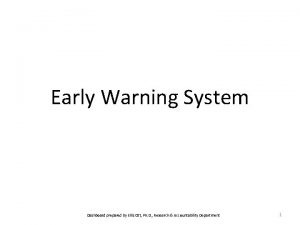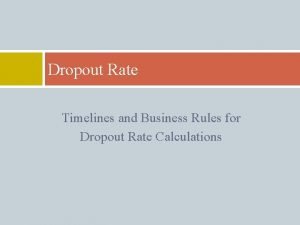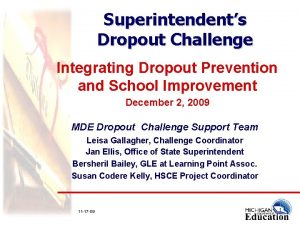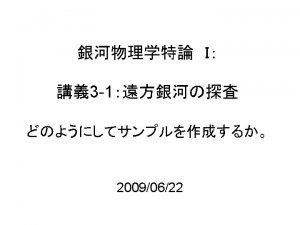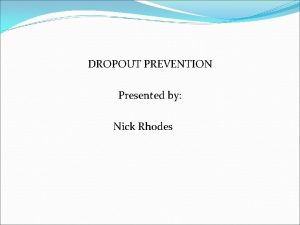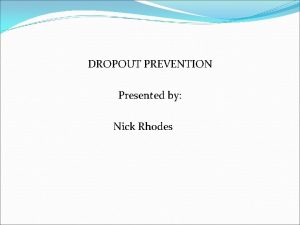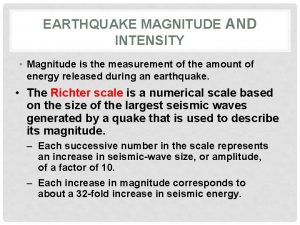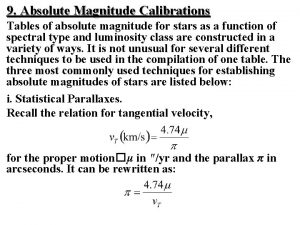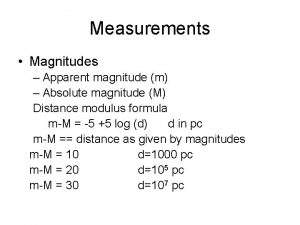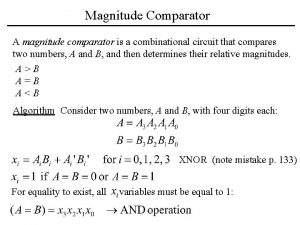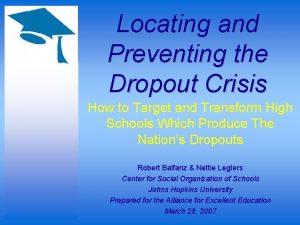The Texas Dropout Crisis Magnitude and Impact A

































- Slides: 33

The Texas Dropout Crisis Magnitude and Impact A LEGISLATIVE BRIEFING ON THE TEXAS DROPOUT CRISIS January 23, 2007, 8: 15 - 10: 00 AM Texas State Capitol, E 2. 026

IDRA Attrition Research 1986 - 2006 Numbers Causes Solutions Dr. Albert Cortez Intercultural Development Research Association

Texas Public School Attrition Rates 1985 -86 33% 1996 -97 43% 2005 -06 35%

Minorities - Persistently Highest Rates Hispanic Attrition African American Attrition White Attrition 1986 2006 47% 36% 40% 28% 21%

IDRA Estimates of Students Lost To Attrition Year Percent Number of Students 1987 -88 33% 86, 276 1996 -97 43% 147, 313 2005 -06 35% 137, 162

Cumulative Students Lost 1986 to 2006 2, 533, 169

Texas Graduation Rates: Comparative Data Dr. Eileen Coppola Rice University Center for Education

Texas Graduation Rates: Comparative Data Sources: l Texas Education Agency l Editorial Projects in Education Research (Education Week) l University of Texas in Dallas/Brown University l The Civil Rights Project at Harvard University l University of Texas in Austin

TEA: Secondary School Completion and Dropouts in Texas Public Schools 2004 -2005 2003 Reported Graduation Rates Statewide 84. 2% African American 81. 1% Hispanic 77. 3% White 89. 8% Asian/Pacific Islander 91. 5% Economically Disadvantaged 77. 8%

TEA: Secondary School Completion and Dropouts in Texas Public Schools 2004 -05, District Supplement, Large Districts District Annual Grade 7 -12 Dropout Rate Longitudinal Grade 9 Cohort Class of 2005 Graduation Rate Longitudinal Grade 9 Cohort Class of 2005 Dropout Rate Houston ISD 2. 4% 73. 8% 12. 5% Dallas ISD 1. 5% 77. 8% 7. 9% Austin ISD 1. 1% 80. 7% 5. 6% El Paso ISD 1. 2% 76. 1% 5. 6% San Antonio ISD 1. 7% 76. 0% 8. 0%

Editorial Projects in Education Research Center: “Diplomas Count” l l l Used the Common Core of Data, an annual federal census Cumulative Promotion Index, which tracks grade to grade promotion The 84. 2% statewide graduation rate reported by the TEA is 17 percentage points higher than the rate of 66. 8% reported in Diplomas Count

Comparison of CPI versus TEA Graduation Rates Statewide and by Ethnicity

Comparison of CPI versus TEA Rates for Major Texas Districts

The High School Pipeline (CPI)

University of Texas in Dallas, Magnus Lofstrom Brown University, John Tyler l l Used longitudinal, student-level data. A student belongs to the graduating class during the year s/he turns 18. A student is defined to be a school dropout if s/he is observed enrolled in a Texas public school at age 15 and by the year s/he turns 20 has not yet graduated nor is enrolled. Study also found that in 1999 GED recipients fared only slightly better than dropouts in the Texas economy.

Texas Official Completion Rate Compared to Lofstrom/Tyler Analysis

Summary l Statewide, the graduation rate is estimated by researchers as currently about 67%, not the 84% estimated by TEA. l The difference comes from removing missing students from the denominator count, and through use of leaver codes that obscure the extent of the crisis.

Summary l l For African American, Latino, and Economically Disadvantaged students statewide, the graduation rate is approximately 60%. In our major urban districts, we see graduation rates that hover around 50%. In addition, one study by Heilig-Vazquez of UT Austin shows ELL graduation rates as low as 20% for a major urban district. These figures are consistent with IDRA’s attrition research.

The Costs of Dropping Out Frances Deviney, Ph. D. , Center for Public Policy Priorities Albert Cortez, Ph. D. , Intercultural Development Research Association

Cost of Dropping Out l l l Cost to the Student Cost to the Education System Cost to the State

Cost to the Individual 2006 Official federal poverty line l Family of 2 < $13, 200/year l Family of 3 < $16, 600/year l Family of 4 < $20, 000/year

Cost to the Individual Source: Median Earnings in Past 12 Months for Texas Population 25 and Over, 2005 American Community Survey, U. S. Census Bureau

Cost to the Individual Texas teens 16 -19 years old not in school and do not have a high school degree: Over 98, 000 Increase in earnings potential if graduated: Single dropout = $9, 211 more / year All dropouts = Over $900 million more / year All dropouts = $3. 6 billion more in four years Source: Tables C 14005 & B 20004, 2005 American Community Survey, U. S. Census Bureau

Cost to the Education System Student Loss Before Graduation: The Class of 2004 9 th & 10 th 68, 000+ 10 th & 11 th 26, 000+ 11 th & 12 th 22, 000+ 12 th & grad 12, 000+ Total = Nearly 130, 000

Cost to the Education System If all 360, 857 students originally enrolled in the 9 th grade in 2000 -2001 stayed in the Texas public school system until graduation in 2004. . . Cost an additional $1. 7 billion This is just the cost for the Class of 2004! And it is a conservative estimate! Source: Deviney, F. P. , & Cavazos, L. (2006). The High Cost of Dropping Out: How Many, How Come, How Much. Center for Public Policy Priorities.

Cost to the State High school dropouts have greater need for government assistance l 4 in 10 receive government assistance (2001, ages 16 -24) l More likely to be unemployed l 8 times as likely to be incarcerated (2006) l Significant loss in tax revenue

Cost to the State IDRA analysis of Social Service Costs l l l Job Training Adult Education Unemployment & Job Placement Crime & Incarceration Lost Wages Lost Tax Revenue

Cost to the State Over time, dropouts from the Class of 1986 cost Texas: $16. 89 billion dollars l l $137, 504 average earnings loss per dropout $58, 930 average loss in taxes Source: Cardenas, J. A. , Robledo, M. R. , & Supik, J. D. (1986). Texas School Dropout Survey Project: A Summary of Findings. IDRA.

Cost to the State Since their initial study, IDRA estimates 2. 5 million students lost Cost of $730. 1 billion to Texas! Source: Johnson, R. (2006). Texas Public School Attrition Study, 2005 -06. IDRA.

Addressing the Dropout Crisis in Texas Principles for Action Dr. Angela Valenzuela, University of Texas, Texas Center for Educational Policy Dr. Robert Sanborn, CHILDREN AT RISK Dr. Albert Cortez, Intercultural Development Research Association

Principles for Action Principle 1: All students enrolled in Texas secondary schools should be expected, and must be supported, to graduate from high school with a regular high school diploma. Principle 2: The state must restore the credibility of official dropout counts by accurately accounting for the educational status of every pupil that entered the 9 th grade in any Texas secondary school. Principle 3: Using Texas’ excellent student-level longitudinal data, the state should implement a transparent and simple methodology to count and report on dropouts. Reporting should be readily available and easily accessible to the public. Reporting must directly inform communities and parents about the status of the issue and progress being made to address it.

Principles for Action Principle 4: State efforts to decrease the dropout rate should recognize and address systemic issues that affect student graduation, documented by research (including teaching quality, curriculum quality and access, student engagement, etc. ) and incorporate both dropout prevention and dropout recovery. Principle 5: Ongoing evaluation must be an integral part of any effort at the state and local level to address the dropout problem. Principle 6: In ensuring that all students graduate, schools should incorporate pedagogical changes that allow them to better adapt to the needs and strengths of their students.

Principles for Action Principle 7: No single criterion (e. g. high stakes testing) should be used to make high school graduation decisions for any individual student. Principle 8: The state must acknowledge shared accountability for the dropout issue at state, district and local levels by investing the personnel and fiscal resources needed to help schools meet state-established graduation targets. Adequate, equitable funding must be allocated to address this crisis. Principle 9: Any response to the dropout issue must be based on valuing Texas families, educators, communities, and students; no response should promote a “deficit model” or blame.
 Parsec distance
Parsec distance Gravis grave
Gravis grave Dropout 線上看
Dropout 線上看 Ott dropout
Ott dropout The college dropout
The college dropout Questionnaire on school dropouts
Questionnaire on school dropouts Hình ảnh bộ gõ cơ thể búng tay
Hình ảnh bộ gõ cơ thể búng tay Bổ thể
Bổ thể Tỉ lệ cơ thể trẻ em
Tỉ lệ cơ thể trẻ em Chó sói
Chó sói Tư thế worm breton
Tư thế worm breton Hát lên người ơi alleluia
Hát lên người ơi alleluia Các môn thể thao bắt đầu bằng tiếng đua
Các môn thể thao bắt đầu bằng tiếng đua Thế nào là hệ số cao nhất
Thế nào là hệ số cao nhất Các châu lục và đại dương trên thế giới
Các châu lục và đại dương trên thế giới Công của trọng lực
Công của trọng lực Trời xanh đây là của chúng ta thể thơ
Trời xanh đây là của chúng ta thể thơ Mật thư tọa độ 5x5
Mật thư tọa độ 5x5 Phép trừ bù
Phép trừ bù Phản ứng thế ankan
Phản ứng thế ankan Các châu lục và đại dương trên thế giới
Các châu lục và đại dương trên thế giới Thơ thất ngôn tứ tuyệt đường luật
Thơ thất ngôn tứ tuyệt đường luật Quá trình desamine hóa có thể tạo ra
Quá trình desamine hóa có thể tạo ra Một số thể thơ truyền thống
Một số thể thơ truyền thống Cái miệng bé xinh thế chỉ nói điều hay thôi
Cái miệng bé xinh thế chỉ nói điều hay thôi Vẽ hình chiếu vuông góc của vật thể sau
Vẽ hình chiếu vuông góc của vật thể sau Nguyên nhân của sự mỏi cơ sinh 8
Nguyên nhân của sự mỏi cơ sinh 8 đặc điểm cơ thể của người tối cổ
đặc điểm cơ thể của người tối cổ Ví dụ giọng cùng tên
Ví dụ giọng cùng tên Vẽ hình chiếu đứng bằng cạnh của vật thể
Vẽ hình chiếu đứng bằng cạnh của vật thể Phối cảnh
Phối cảnh Thẻ vin
Thẻ vin đại từ thay thế
đại từ thay thế



